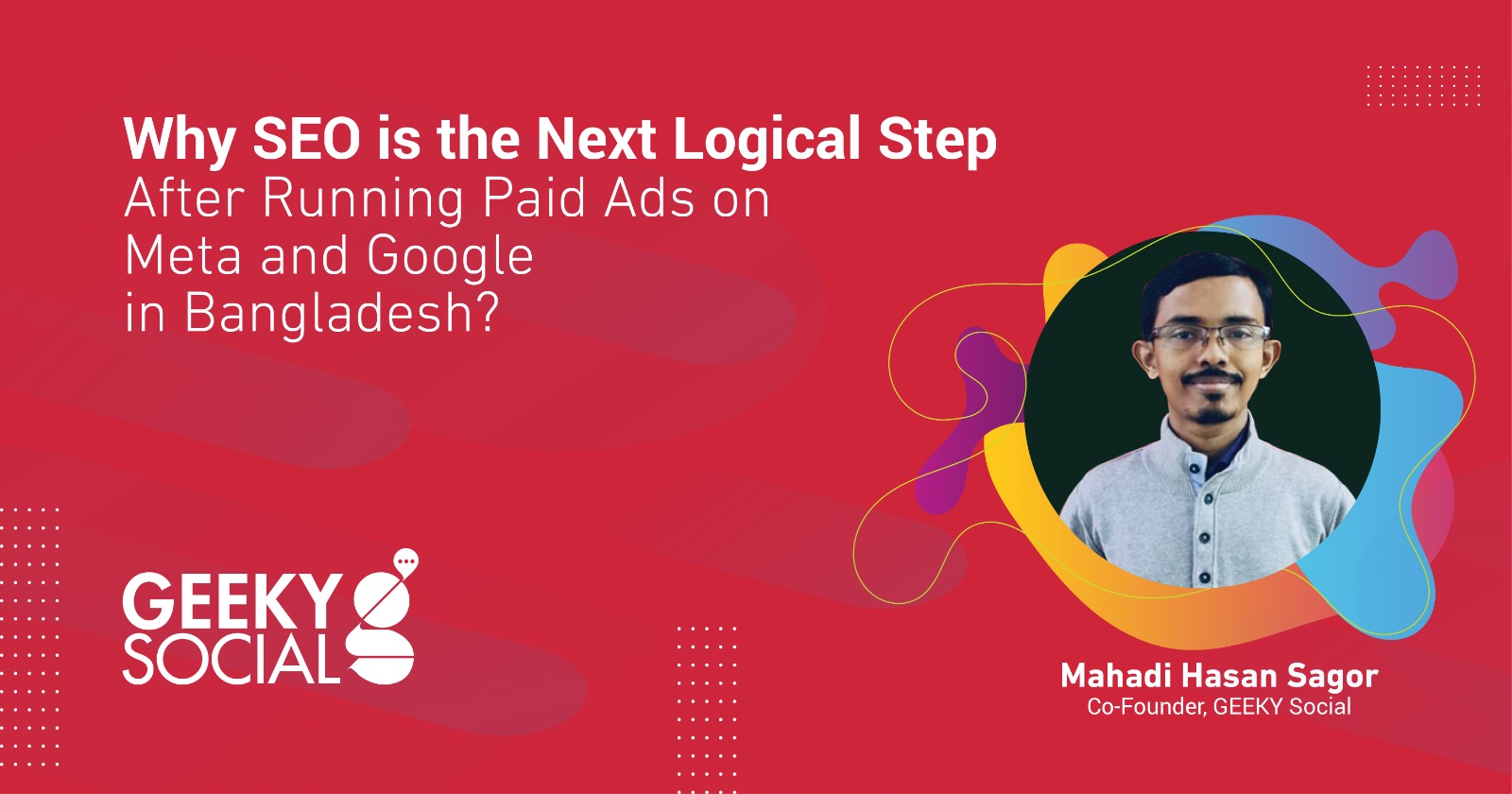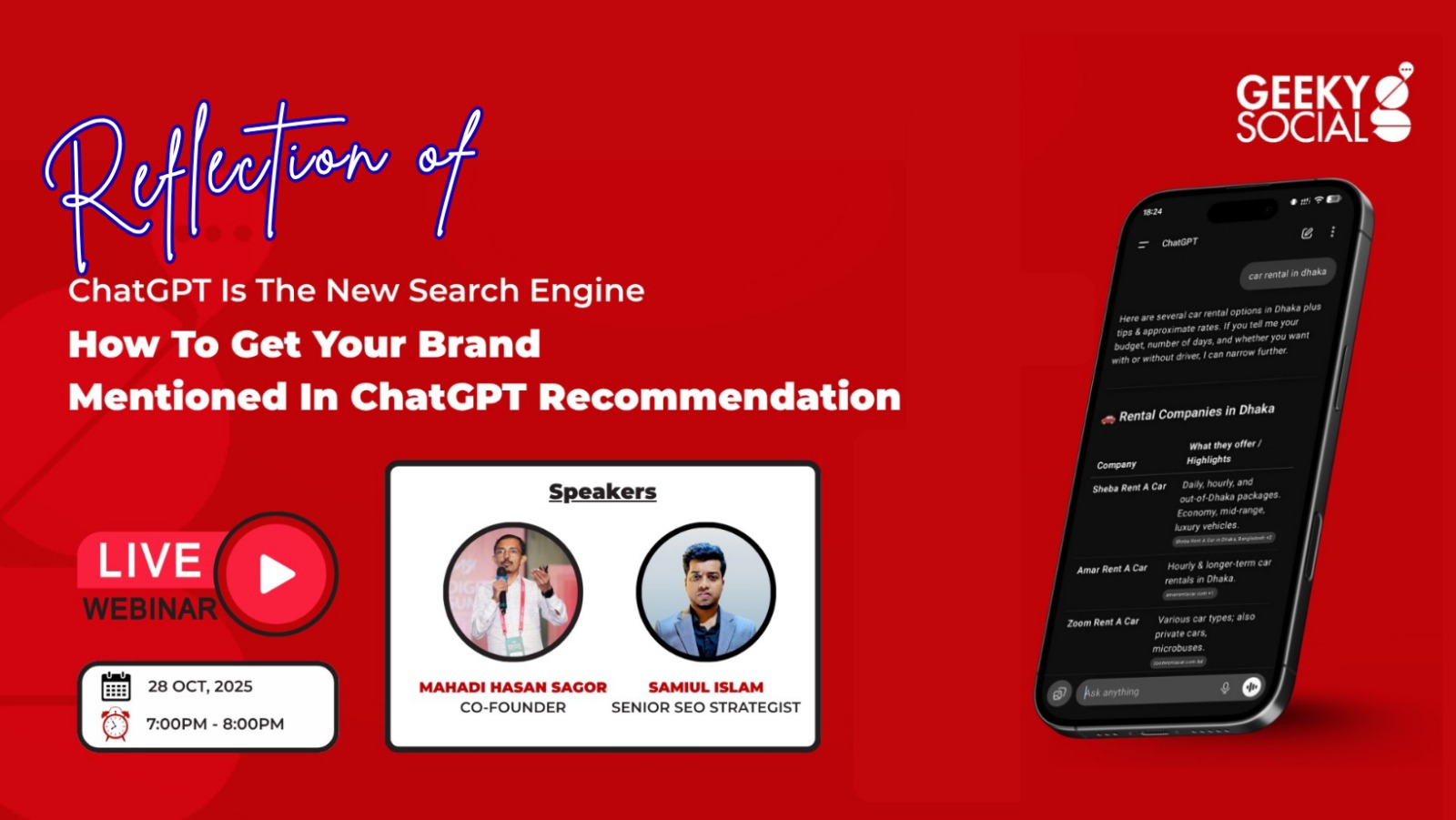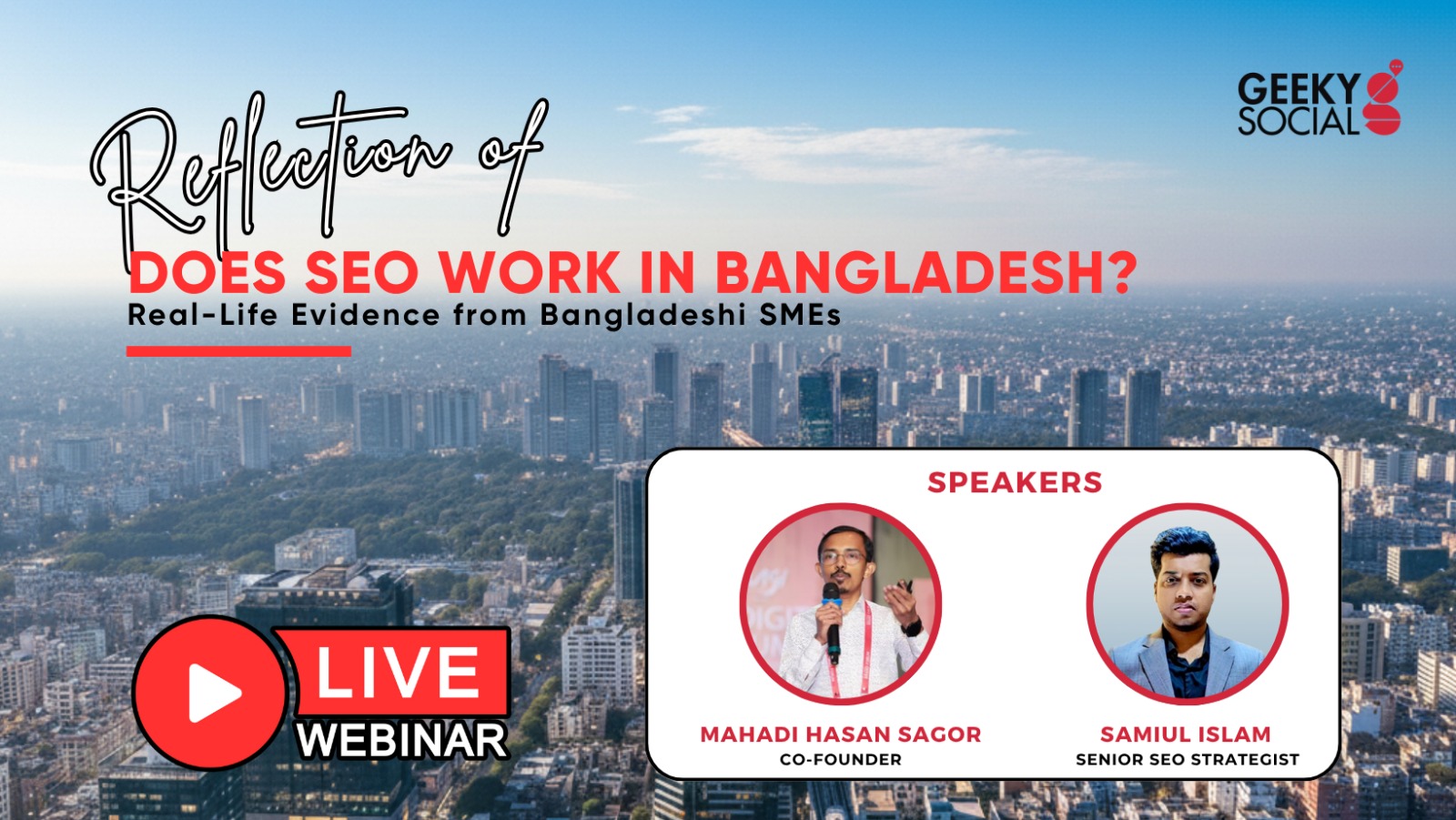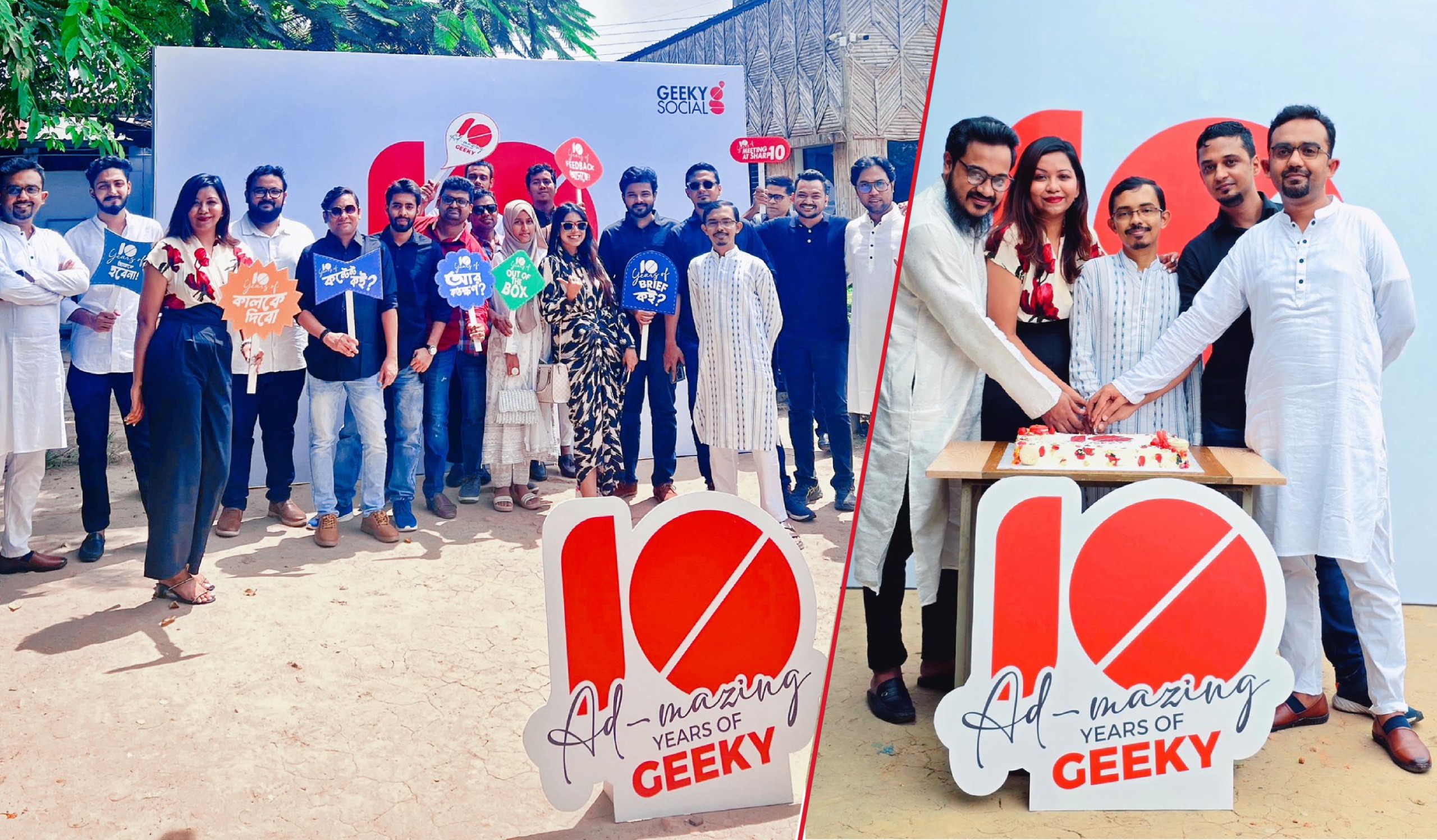
Why SEO is the Next Logical Step After Running Paid Ads on Meta and Google in Bangladesh?
- Published on

Table of Contents
Paid advertising on platforms like Meta (Facebook and Instagram) and Google is often the first choice for businesses looking to drive quick results. These platforms offer immediate visibility, targeting precision, and measurable outcomes. However, once the initial momentum is achieved, the next logical step for sustainable growth is to invest in Search Engine Optimization (SEO). Unlike paid ads, SEO builds long-term value, providing a steady stream of organic traffic that doesn’t rely on a continuous ad spend. In this article, our team at GEEKY Social explores why transitioning to SEO after paid advertising is a strategic move, supported by real-world case studies and actionable insights.
SEO Enhances the Impact of Paid Ads
Over time, the same audience exposed to the same ads repeatedly experiences ad fatigue, reducing click-through rates and increasing cost-per-click. In contrast, well-executed SEO continues to attract fresh visitors through ever-green content and high-ranking pages that maintain relevance over time.
A strong SEO strategy directly benefits our paid ad campaigns. High-quality content and a well-optimized website improve ad quality scores, which in turn lowers the cost-per-click (CPC). This creates a synergistic effect where both SEO and paid ads complement each other, maximizing the effectiveness of our digital marketing efforts.
Quality Score is a metric that influences both ad rankings and the cost-per-click (CPC). A well-optimized landing page that aligns with our ad content and keywords can improve our Ad Quality Score. SEO ensures that our landing pages are relevant and high-quality, leading to better ad performance. Higher quality scores can lead to lower CPCs. This means that we can get more value from our ad budget if our landing pages are optimized through SEO.
Case Study: Dollar Shave Club
Dollar Shave Club, known for its viral video marketing campaign, initially relied heavily on paid ads. However, as competition increased and ad costs surged, the company transitioned to SEO. By optimizing their blog content, they captured search intent for grooming-related queries, leading to sustained organic traffic growth and reduced dependency on paid ads.
SEO Builds Strong Brand Authority
27% people search for more information about a business after seeing a display Ad. To get best out of our digital media spending we must do a proper SEO of our website so users get the right set of information to complement in their purchase journey.
Consistent organic search visibility builds brand authority. When users repeatedly see our brand in both paid ads and organic search results, it reinforces trust and credibility. This can increase the click-through rates (CTR) of our ads and lead to higher conversion rates.
Case Study: Moz
Moz, a company specializing in SEO tools, has successfully integrated SEO and paid advertising to dominate the search landscape. Their content-driven SEO strategy positions them as a thought leader, while their targeted paid ads amplify their reach. This dual approach has made Moz a go-to resource for SEO professionals, further boosting their brand authority.
Lower Customer Acquisition Costs
SEO is inherently cost-effective compared to paid advertising. While the upfront investment in SEO may be high, the ongoing cost is minimal. Once we achieve high rankings, the flow of organic traffic is virtually free. This can significantly lower our customer acquisition costs (CAC) over time.
One of the most compelling advantages of SEO is its compounding effect. A well-optimized page can continue to rank for years, bringing in a consistent stream of visitors without additional effort. Paid ads, however, require constant funding and optimization, making it harder to achieve long-term ROI.
Case Study: Stygen.gift
Stygen.gift a gift e-commerce marketplace based in Bangladesh relied heavily on paid ads for their new customer acquisition and over time the CAC (Customer Acquisition Cost) went so high that it was very tough to remain profitable. Then with the help of GEEKY Social’s successful SEO strategy, they are now able to generate a good amount of traffic (looking for gifts on various occasions) from search engine, which helped them reduce their CAC significantly.
SEO Helps Building a Strong Customer Acquisition Funnel
SEO allows us to capture potential customers at different stages of the buying journey. Through targeted content, we can attract users who are in the research phase, offering value without the hard sell. This builds a relationship that can eventually lead to a conversion.
Unlike paid ads, where targeting long-tail keywords can be cost-prohibitive, SEO enables us to capture niche audiences through optimized content. These visitors often have higher intent and are more likely to convert, making SEO a powerful tool for targeting specific customer segments.
Case Study: Khaas Food
A retail safe food brand based in Bangladesh started investing in SEO along with paid marketing from day one. This strategy helped the company capture real intended traffics who are actively looking to buy organic & safe food from Bangladesh/Dhaka. A little push with retargeting these visitors through Google & Meta converted them as a sticky customer for the brand.
SEO Provides Useful Data-Driven Insights for The Company
SEO analytics offer valuable insights into how users interact with our site, what content resonates, and which keywords drive the most traffic. This data can be used to refine our paid ad strategies, ensuring that we’re targeting the right audience with the right message.
The insights gained from SEO also contributes to plan our content strategy. By analyzing which pages perform well organically, we can create similar content for paid ads, optimizing our campaigns for better results. This creates a feedback loop where both SEO and paid ads continuously improve.
Case Study: Airbnb
Airbnb uses SEO data to understand search trends and user behavior, which informs their overall marketing strategy. They’ve identified key content themes that resonate with their audience, using this information to create both paid and organic campaigns. This data-driven approach has been instrumental in scaling their global presence.
SEO is not just a marketing tactic; it’s a long-term digital asset. Once our site ranks well, it becomes a valuable property that continues to generate leads and sales with minimal ongoing investment. This is particularly important in competitive industries where paid ads alone may not be enough to sustain growth.
Paid ads are like a faucet; they deliver traffic as long as we’re willing to pay. However, the moment we turn off the ad spend, the traffic stops. This can create a dependency that isn’t sustainable in the long run, especially for small to medium-sized businesses. SEO, on the other hand, is like planting a tree—it takes time to grow but provides shade for years to come.
So, its high time every company/brand should consider investing in SEO today along with paid marketing.
Need help? Contact GEEKY.
Share Now on social media
Join Our Newsletter
Stay up-to-date with latest media insights and updates





